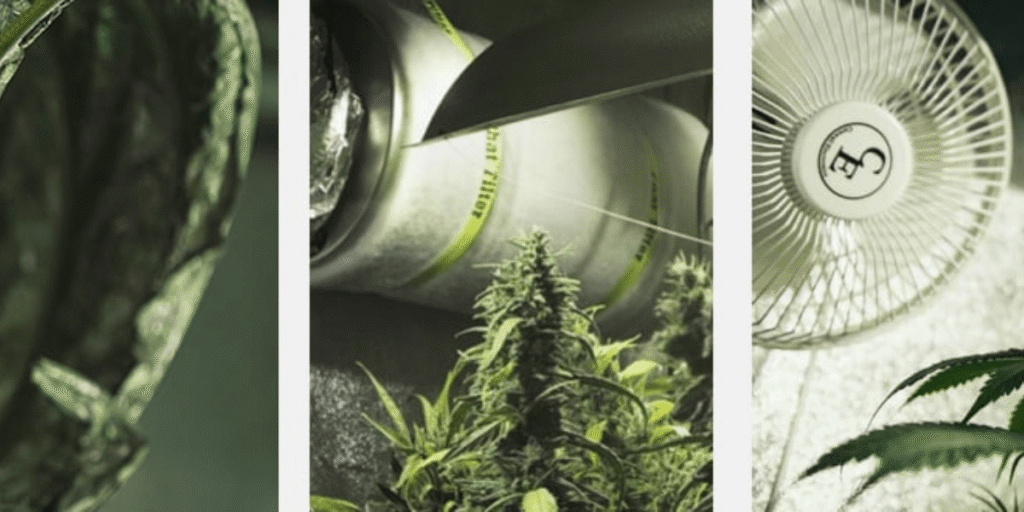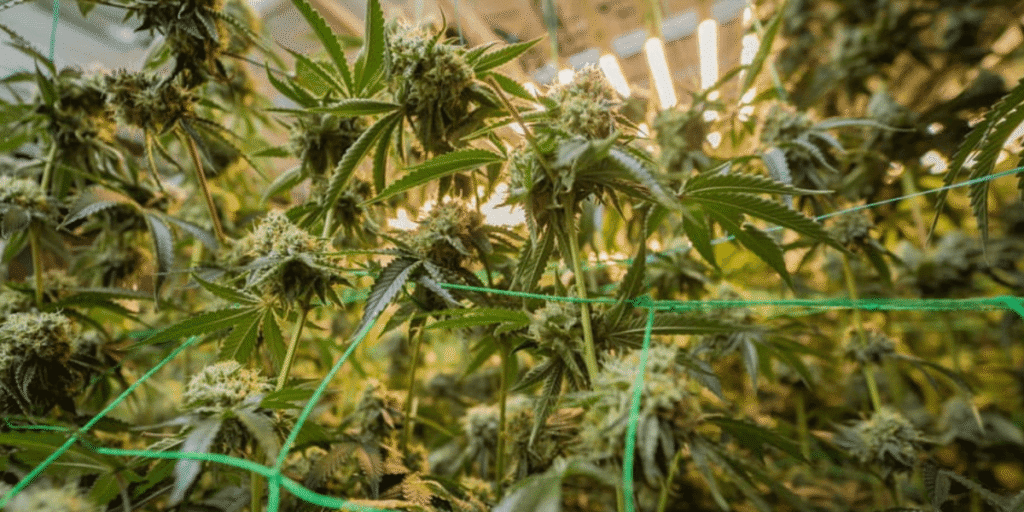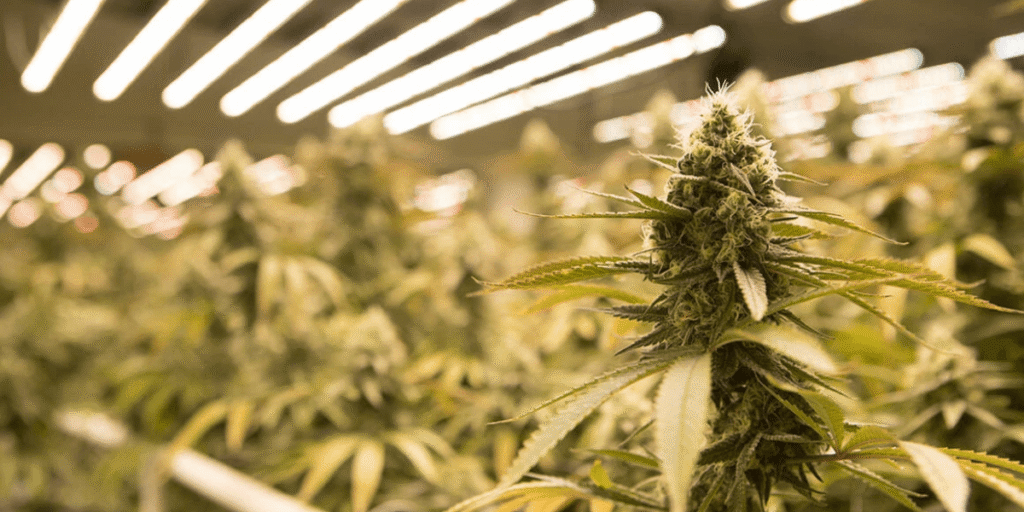The importance of airflow in cannabis is more than a technical detail, it is a game-changer for your entire grow. If you’re pouring time and energy into lighting, nutrients, and watering schedules but still facing slow growth or mold outbreaks, it’s time to ask a crucial question.
Have you truly created a breathing space for your plants?In this article, we will explore why airflow is essential for your cannabis plants, how it affects their health and yield, and practical ways to optimize ventilation in your grow space. Let’s dive into the unseen force that can make or break your crop.
The Important of Airflow in Cannabis Plant Health
Imagine a stuffy, sealed room it’s uncomfortable for you, and it’s detrimental to your plants. Cannabis thrives in fresh, moving air.
Airflow and CO₂ Exchange in Cannabis Cultivation
Plants absorb carbon dioxide (CO₂) for photosynthesis and release oxygen through tiny pores on their leaves called stomata. Stagnant air creates a “boundary layer” around leaves, depleting CO₂ and trapping oxygen. Effective airflow continuously brings fresh CO₂ to the leaf surface and carries away excess oxygen, ensuring high-efficiency gas exchange for vigorous growth.
How Air Movement Supports Nutrient Uptake in Cannabis
Transpiration is the process where plants release water vapor from their leaves, essential for water transport and cooling. Good airflow efficiently removes this transpired moisture, preventing high humidity around the leaves and promoting healthy transpiration, which in turn drives continuous nutrient absorption from the roots.
Controlling Temperature and Humidity with Cannabis Ventilation
Grow lights generate significant heat, leading to localized hot spots and heat stress if not managed. Simultaneously, plant transpiration increases ambient humidity. Proper air movement evenly distributes heat and removes excess moisture, preventing humidity buildup that invites mold and disease, especially critical during the sensitive flowering stage.
Stronger Cannabis Growth Through Consistent Air Circulation
Consistent, gentle airflow mimics natural wind. This subtle stress encourages cannabis plants to develop stronger stems and more robust structures, helping them support heavier buds later on. By optimizing gas exchange and transpiration, airflow directly contributes to higher photosynthetic rates, leading to increased overall plant vigor and maximized yields.
Preventing Pests and Disease with Proper Cannabis Airflow
High humidity and stagnant air are ideal breeding grounds for common cannabis foes like mold spores (e.g., powdery mildew, bud rot) and various pests (e.g., spider mites, fungus gnats). Good airflow creates an unfavorable, drier environment for these issues, serving as a natural, passive defense mechanism.
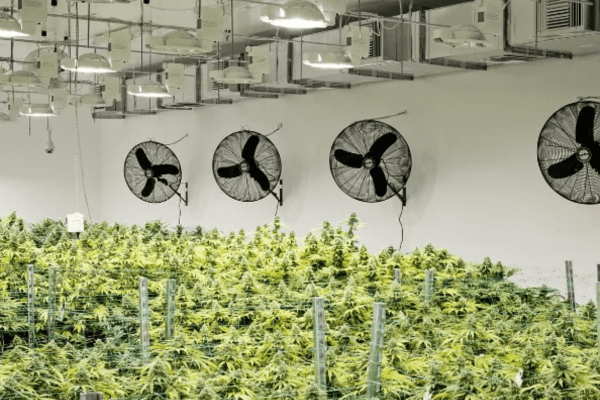
Why Poor Air Circulation Is a Risk in Cannabis Growing
Neglecting airflow is akin to suffocating your plants, leading to a cascade of problems that can severely impact your grow.
Mold and Pathogen Problems Caused by Inadequate Airflow
Poor ventilation means high humidity lingers, providing the perfect conditions for dreaded fungal diseases like bud rot (Botrytis cinerea) and powdery mildew to take hold and spread rapidly, often devastating entire crops. It also allows airborne pathogens to accumulate.
The Impact of Limited Ventilation on Cannabis Growth
When air is stagnant, gas exchange is inefficient, and plants struggle to “breathe” and process CO₂. This directly leads to slowed metabolic processes, stunted growth, and ultimately, significantly reduced yields.
Heat Stress in Cannabis from Bad Air Distribution
Without air movement, heat from grow lights concentrates in specific areas, creating hot spots. These areas subject plants to heat stress, causing leaf burn, wilting, and impaired physiological functions.
Air Quality and Its Effect on Cannabis Terpenes and Cannabinoids
Especially during flowering, excessively high humidity due to poor airflow can negatively affect the development of terpenes and cannabinoids. This compromises the final product’s aroma, flavor, and overall potency.
Designing an Air Circulation System for Cannabis Grows
An effective airflow system is a combination of vertical and horizontal air movement, designed to create a dynamic and healthy growing environment.
Setting Up Intake and Exhaust to Improve Cannabis Airflow
Your system needs both intake (bringing fresh air in) and exhaust (removing stale air). Intake can be passive (simple vents) or active (intake fans). Exhaust is typically active using an inline fan, often paired with a carbon filter for odor control. Many growers aim for a slight negative pressure where exhaust volume is slightly higher than intake to ensure all air exits through the filter, containing odors and preventing contaminants from entering.
Where and How to Place Fans for Cannabis Ventilation
- Oscillating Fans: These are indispensable for mimicking natural breezes, ensuring even air distribution across the canopy. Place them strategically so air moves through and around plants, not just over them.
- Clip-on Fans: Ideal for targeted airflow, especially within dense canopies or below plants to address specific moist areas.
- Floor/Box Fans: Provide broader air circulation for larger grow spaces.
- Inline Duct Fans: The powerhouse of your ventilation system, used for powerful intake or exhaust through ducting.
- Avoid Direct Blowing (Wind Burn): Never aim fans directly at plants for extended periods. This causes “wind burn,” manifesting as curled, crispy, or yellowed leaves from excessive transpiration. Instead, ensure gentle, consistent air movement.
- Multiple Small Fans vs. One Large: Often, several smaller fans placed strategically offer more uniform and comprehensive coverage than a single large fan, effectively eliminating dead air spots.
Layered Airflow Techniques for Full Canopy Coverage
Consider airflow in layers:
- Bottom Layer: Combat humidity around pots and soil to prevent fungus gnats and root issues.
- Mid-Layer (Canopy): Ensure air moves through the plant’s foliage to facilitate transpiration and gas exchange.
- Top Layer: Remove rising heat and stale air, often where exhaust fans are positioned.
Filtration and Clean Airflow in Cannabis Grow Rooms
Beyond carbon filters for odor, consider HEPA filters for intake air. These can effectively capture dust, pollen, mold spores, and other airborne particulates, leading to a cleaner grow environment and further reducing the risk of introducing pathogens.
Vertical Farming: Airflow Strategies for Cannabis Racks
In space-efficient vertical farming or multi-tier systems, airflow design is more complex. Each level requires dedicated air circulation and exchange to ensure uniform CO₂ distribution, temperature stability, and humidity control across all plants, often necessitating specific fan types and ducting solutions.
Airflow Needs for Cannabis: From Seedling to Veg Stage
Fine-tuning your airflow strategy throughout the cannabis life cycle can significantly impact plant health and yield.
Optimizing Airflow During Cannabis Flowering
- Seedling Stage: Young seedlings are delicate. Provide gentle, indirect airflow to avoid stressing them. Focus on stable temperature and moderate humidity.
- Vegetative Stage: As plants grow, increase airflow intensity. Stronger, consistent air movement promotes robust stem and branch development, building a sturdy framework for future buds. For more detailed insights on maximizing this crucial phase, explore our cannabis vegetative stage tips.
Managing Air Movement Before Cannabis Harvest
This is a critical stage. Lower humidity is paramount to prevent mold. Increase fan intensity to ensure air constantly moves through the developing buds, keeping them dry and maximizing CO₂ delivery for optimal bloom development.
Balancing CO₂ Supplementation with Air Circulation
Maintain stable, gentle ventilation in the days leading up to harvest. This helps keep buds dry and supports the preservation of delicate terpenes and cannabinoids, ensuring peak flavor, aroma, and potency in your final product.
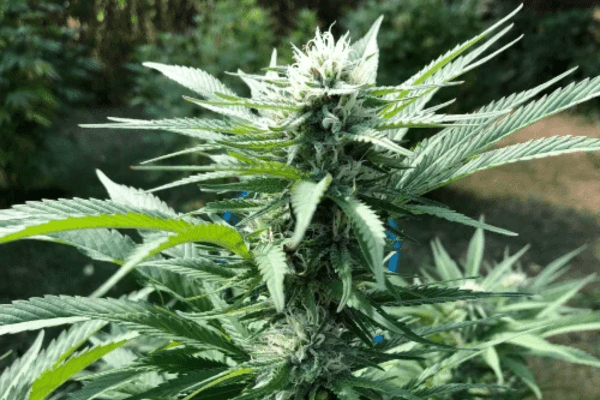
Tools to Monitor and Control Airflow in Cannabis Tents
If you’re supplementing your grow with CO₂ to boost growth rates, airflow is non-negotiable. CO₂ is denser than air, and without vigorous air circulation, it will simply sink to the bottom of your grow space instead of reaching the leaves. Airflow acts as the essential “carrier,” ensuring CO₂ is uniformly mixed and delivered to every leaf surface for maximum absorption and benefit.
Top Airflow Mistakes in Cannabis and How to Fix Them
Leverage technology to streamline your airflow management and achieve peak efficiency.
- Anemometers & Thermo-Hygrometers: Essential basic tools for real-time monitoring of air speed, temperature, and humidity, allowing for immediate adjustments.
- Environmental Control Systems (with Sensors): Advanced systems that connect to various environmental sensors (temp, humidity, CO₂) and automatically adjust fan speeds, trigger exhaust fans, and manage other grow room parameters based on predefined setpoints, ensuring precise, automated control.
- Timers & Adjustable Speed Fans: Use timers to automate fan operation cycles, and pair them with adjustable speed fans (e.g., EC motor fans) to fine-tune airflow intensity based on specific needs, leading to energy savings.
Tips to Improve Air Circulation in Cannabis Environments
Avoid these common pitfalls to maximize your airflow’s effectiveness.
- The “More Wind is Better” Myth: Excessive wind causes plant stress and “wind burn.” The goal is consistent, even circulation, not brute force.
- Ignoring Nighttime Humidity Buildup: Photosynthesis stops at night, but plants still transpire, and humidity can accumulate. Maintain some airflow even in darkness to prevent condensation and mold growth.
- Overlooking Dead Air Spots: Corners, dense canopy interiors, and areas around equipment often become “dead zones” without proper air movement. Strategic fan placement or adding more smaller fans can eliminate these.
- Energy Efficiency: Ventilation systems are significant energy consumers. Invest in energy-efficient EC motor fans and use smart controllers to adjust speeds according to actual demand, rather than running at full power 24/7.
- Troubleshooting Airflow Issues: Look for signs like curled, crispy leaves (wind burn), droopy foliage (over-transpiration), or a musty smell (mold). These indicate an airflow problem requiring immediate adjustment of fan placement, intensity, or ventilation system load. For broader insights into preventing and solving other common cannabis cultivation challenges that can arise from environmental imbalances, including those often exacerbated by inadequate air circulation, explore our comprehensive guide.
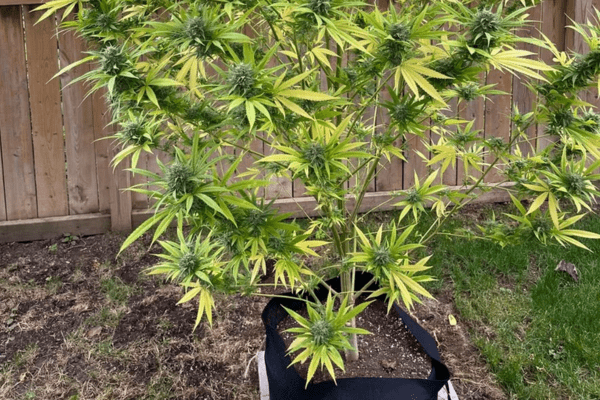
Cannabis Airflow FAQs: Grow Room Ventilation Essentials
Q1: How do I calculate the right size exhaust fan for my grow space?
A1: Measure your grow area’s volume by multiplying Length × Width × Height. Your exhaust fan should ideally replace all the air in the space every 1–3 minutes. For instance, a 4×4×7 ft tent (112 cubic feet) needs a fan rated at least 112 CFM. Add 20–30% more capacity if you use strong lights or grow in warm environments.
Q2: My plant’s leaves are curling and look burnt on the edges. Is it wind burn?
A2: Yes, likely. Wind burn happens when strong airflow is constantly hitting the same spot on a plant, causing excessive moisture loss. Reposition fans to oscillate or bounce air off walls, creating a soft breeze that moves leaves gently.
Q3: I smell a musty odor in my grow space. What’s wrong with my airflow?
A3: That smell indicates high humidity and poor airflow perfect conditions for mold. Check humidity levels immediately, ensure your exhaust fan is effectively removing moist air, and add circulation fans to eliminate stagnant areas.
Q4: My CO₂ supplementation isn’t yielding results. Why?
A4: CO₂ tends to settle low without proper circulation. If fans aren’t mixing the air well, your plants won’t absorb the CO₂ effectively. Use oscillating fans to evenly distribute CO₂ throughout the canopy for better growth results.
Q5: Should I run my circulation fans 24/7?
A5: Yes, ideally. Even during the dark cycle, airflow prevents condensation and mold. You can reduce fan speed at night to save energy, but full shutdown is discouraged unless humidity is tightly controlled.
Final Thoughts on the Importance of Air Circulation in Cannabis
Every breath your cannabis plants take, every subtle rustle of their leaves, is a testament to the power of proper airflow. It’s truly more than just circulating “fresh air”; it’s the invisible architect supporting every essential process, from basic cellular functions to the intricate development of your harvest’s quality and quantity. Whether it’s managing precise gas exchange, fending off unseen pathogens, or ensuring your CO₂ enrichment hits its mark, intelligently designed air circulation is the silent cornerstone of a truly thriving garden.
By embracing these principles and investing in an airflow system that’s as thoughtfully managed as your nutrient regimen, you’re not just optimizing conditions, you’re cultivating an environment where your plants don’t just survive, but truly flourish.
Ready to transform your grow? Take a moment today to re-evaluate your space. Feel for those subtle breezes in every corner, ensuring your cannabis plants can breathe freely, deeply. The reward? A noticeably healthier, more vigorous crop, bursting with richer aromas, enhanced potency, and ultimately, a profoundly more satisfying harvest experience.
Got your own tips or success stories? Share them with us in the comments or tag us on Instagram @Greenfuturelight . Let’s grow stronger together and make every harvest better than the last!
For more expert advice on maintaining the perfect grow environment and nurturing robust plant health, visit our website: www.greenfuturelight.com
Looking for advanced solutions to fine-tune your grow room’s climate? Check out our Grow Light Collection >>
Need personalized guidance for your unique setup? Contact Us Now >>
Let’s work together to cultivate gardens where every plant thrives, every bud excels, and every harvest is your best yet.

